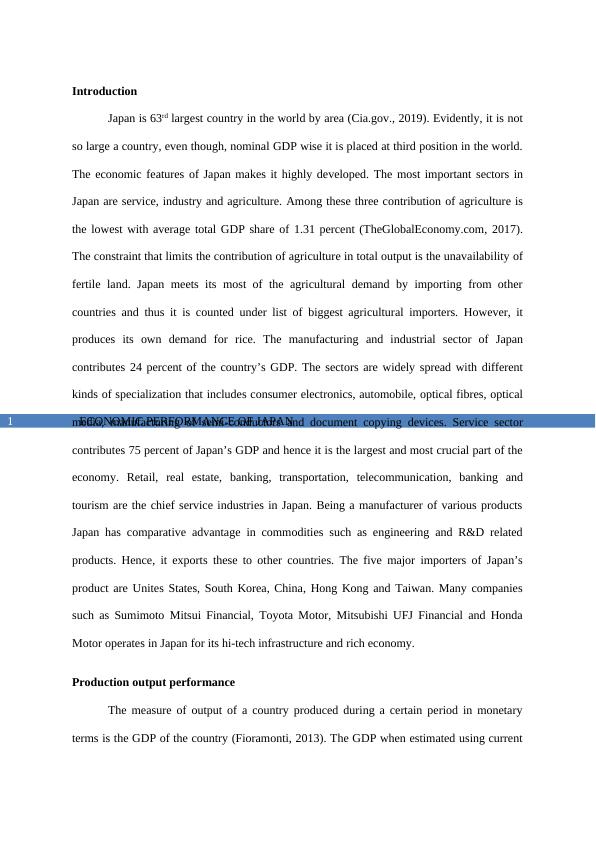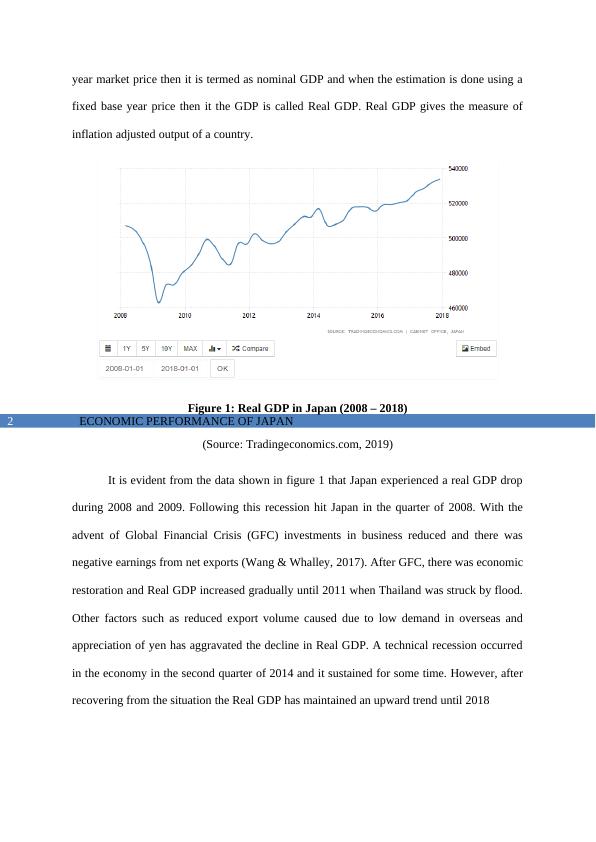Economic Performance of Japan: Real GDP, Unemployment, and Price Level Analysis
Added on 2022-11-17
13 Pages2771 Words494 Views
Running head: ECONOMIC PERFORMANCE OF JAPAN
Economic Performance of Japan
Name of the Student
Name of the University
Course ID
Economic Performance of Japan
Name of the Student
Name of the University
Course ID

ECONOMIC PERFORMANCE OF JAPAN1
Introduction
Japan is 63rd largest country in the world by area (Cia.gov., 2019). Evidently, it is not
so large a country, even though, nominal GDP wise it is placed at third position in the world.
The economic features of Japan makes it highly developed. The most important sectors in
Japan are service, industry and agriculture. Among these three contribution of agriculture is
the lowest with average total GDP share of 1.31 percent (TheGlobalEconomy.com, 2017).
The constraint that limits the contribution of agriculture in total output is the unavailability of
fertile land. Japan meets its most of the agricultural demand by importing from other
countries and thus it is counted under list of biggest agricultural importers. However, it
produces its own demand for rice. The manufacturing and industrial sector of Japan
contributes 24 percent of the country’s GDP. The sectors are widely spread with different
kinds of specialization that includes consumer electronics, automobile, optical fibres, optical
media, manufacturing of semi-conductors and document copying devices. Service sector
contributes 75 percent of Japan’s GDP and hence it is the largest and most crucial part of the
economy. Retail, real estate, banking, transportation, telecommunication, banking and
tourism are the chief service industries in Japan. Being a manufacturer of various products
Japan has comparative advantage in commodities such as engineering and R&D related
products. Hence, it exports these to other countries. The five major importers of Japan’s
product are Unites States, South Korea, China, Hong Kong and Taiwan. Many companies
such as Sumimoto Mitsui Financial, Toyota Motor, Mitsubishi UFJ Financial and Honda
Motor operates in Japan for its hi-tech infrastructure and rich economy.
Production output performance
The measure of output of a country produced during a certain period in monetary
terms is the GDP of the country (Fioramonti, 2013). The GDP when estimated using current
Introduction
Japan is 63rd largest country in the world by area (Cia.gov., 2019). Evidently, it is not
so large a country, even though, nominal GDP wise it is placed at third position in the world.
The economic features of Japan makes it highly developed. The most important sectors in
Japan are service, industry and agriculture. Among these three contribution of agriculture is
the lowest with average total GDP share of 1.31 percent (TheGlobalEconomy.com, 2017).
The constraint that limits the contribution of agriculture in total output is the unavailability of
fertile land. Japan meets its most of the agricultural demand by importing from other
countries and thus it is counted under list of biggest agricultural importers. However, it
produces its own demand for rice. The manufacturing and industrial sector of Japan
contributes 24 percent of the country’s GDP. The sectors are widely spread with different
kinds of specialization that includes consumer electronics, automobile, optical fibres, optical
media, manufacturing of semi-conductors and document copying devices. Service sector
contributes 75 percent of Japan’s GDP and hence it is the largest and most crucial part of the
economy. Retail, real estate, banking, transportation, telecommunication, banking and
tourism are the chief service industries in Japan. Being a manufacturer of various products
Japan has comparative advantage in commodities such as engineering and R&D related
products. Hence, it exports these to other countries. The five major importers of Japan’s
product are Unites States, South Korea, China, Hong Kong and Taiwan. Many companies
such as Sumimoto Mitsui Financial, Toyota Motor, Mitsubishi UFJ Financial and Honda
Motor operates in Japan for its hi-tech infrastructure and rich economy.
Production output performance
The measure of output of a country produced during a certain period in monetary
terms is the GDP of the country (Fioramonti, 2013). The GDP when estimated using current

ECONOMIC PERFORMANCE OF JAPAN2
year market price then it is termed as nominal GDP and when the estimation is done using a
fixed base year price then it the GDP is called Real GDP. Real GDP gives the measure of
inflation adjusted output of a country.
Figure 1: Real GDP in Japan (2008 – 2018)
(Source: Tradingeconomics.com, 2019)
It is evident from the data shown in figure 1 that Japan experienced a real GDP drop
during 2008 and 2009. Following this recession hit Japan in the quarter of 2008. With the
advent of Global Financial Crisis (GFC) investments in business reduced and there was
negative earnings from net exports (Wang & Whalley, 2017). After GFC, there was economic
restoration and Real GDP increased gradually until 2011 when Thailand was struck by flood.
Other factors such as reduced export volume caused due to low demand in overseas and
appreciation of yen has aggravated the decline in Real GDP. A technical recession occurred
in the economy in the second quarter of 2014 and it sustained for some time. However, after
recovering from the situation the Real GDP has maintained an upward trend until 2018
year market price then it is termed as nominal GDP and when the estimation is done using a
fixed base year price then it the GDP is called Real GDP. Real GDP gives the measure of
inflation adjusted output of a country.
Figure 1: Real GDP in Japan (2008 – 2018)
(Source: Tradingeconomics.com, 2019)
It is evident from the data shown in figure 1 that Japan experienced a real GDP drop
during 2008 and 2009. Following this recession hit Japan in the quarter of 2008. With the
advent of Global Financial Crisis (GFC) investments in business reduced and there was
negative earnings from net exports (Wang & Whalley, 2017). After GFC, there was economic
restoration and Real GDP increased gradually until 2011 when Thailand was struck by flood.
Other factors such as reduced export volume caused due to low demand in overseas and
appreciation of yen has aggravated the decline in Real GDP. A technical recession occurred
in the economy in the second quarter of 2014 and it sustained for some time. However, after
recovering from the situation the Real GDP has maintained an upward trend until 2018

ECONOMIC PERFORMANCE OF JAPAN3
Real GDP growth rate
Economic growth of a country is measured with Real GDP growth. A trend of
increasing growth in Real GDP depicts output of a country increases over time that leads to
economic progress (Feldstein, 2017). Growth of Real GDP is measured year wise in
percentage terms.
Figure 2: Trend in real GDP growth rate of Japan (2008 – 2018)
(Source: Tradingeconomics.com, 2019)
In 2008, Japan experienced economic recession causing decline in Real GDP Growth
starting from third quarter of the year. After recovering from the recession, Real GDP grew
significantly until 2011. From 2011, the economy again slowed down and featured declining
growth trend. The fluctuation in the growth indicated oscillating business cycle trend. From
the second quarter of 2014, there was severe economic contraction of 7.3 percent and the
GDP declined at 1.6 percent annual rate.
Real GDP growth rate
Economic growth of a country is measured with Real GDP growth. A trend of
increasing growth in Real GDP depicts output of a country increases over time that leads to
economic progress (Feldstein, 2017). Growth of Real GDP is measured year wise in
percentage terms.
Figure 2: Trend in real GDP growth rate of Japan (2008 – 2018)
(Source: Tradingeconomics.com, 2019)
In 2008, Japan experienced economic recession causing decline in Real GDP Growth
starting from third quarter of the year. After recovering from the recession, Real GDP grew
significantly until 2011. From 2011, the economy again slowed down and featured declining
growth trend. The fluctuation in the growth indicated oscillating business cycle trend. From
the second quarter of 2014, there was severe economic contraction of 7.3 percent and the
GDP declined at 1.6 percent annual rate.

End of preview
Want to access all the pages? Upload your documents or become a member.
Related Documents
Economics: Production Output Performance, Unemployment, and Price Level Analysislg...
|15
|3073
|20
Economics Assignment 2022lg...
|12
|2818
|21
Economic Analysis of Japan Assignment 2022lg...
|12
|2736
|20
Economic Performance of the United States Assignment 2022lg...
|12
|2422
|7
Economic Performance of Australia: Analysis of GDP, Unemployment Rate and Inflation Ratelg...
|13
|2832
|80
Assignment on Economics and GDP 2022lg...
|13
|3156
|16
